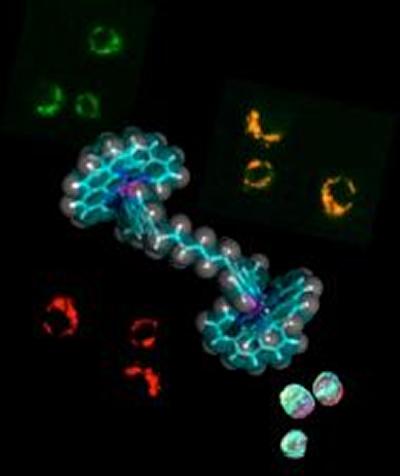Polypyridyl ruthenium(II) complexes as cytotoxic lipophilic cations: new paradigms for old molecules? Seminar

- Time:
- 15:00
- Date:
- 3 June 2015
- Venue:
- Building 27, Room 2003 Chemistry University of Southampton Southampton SO17 1BJ
For more information regarding this seminar, please email Geoff Hyett at G.Hyett@soton.ac.uk .
Event details
Emeritus Professor F. Richard Keene presents a seminar as part of the FIMS research sections seminar series.
There has been considerable interest in the use of inert polypyridylruthenium(II) complexes for biological applications. The ability of such complexes to bind nucleic acids with some degree of specific sequence and structure recognition has highlighted their potential as diagnostic and therapeutic agents. In most cases, the cytotoxicity of the ruthenium(II) complexes has been attributed to their interactions with nucleic acids.1
We have synthesised a series of dinuclear ruthenium polypyridyl complexes where the two ruthenium centers are linked by a chain of 2-16 methylene groups: these species have a high affinity for non-duplex DNA structures,1,2 and are highly cytotoxic to leukaemia cells where the cytotoxicity is proportional to chain length.3 Interestingly, the DNA affinity trends show little correlation with the cytotoxic properties. A detailed study on their cytotoxicity, uptake mechanism and localisation has shown they act as highly cytotoxic lipophilic cations, entering the cell by passive diffusion (with a minor protein-mediated active transport component), poisoning the mitochondria and causing cell death by apoptosis.3
Importantly, this genre of complexes also exhibited high levels of antimicrobial activity against a range of pathogens, including multi-drug resistant strains such as methicillinresistant Staphylococcus aureus (MRSA) and Pseudomonas aeruginosa.4-6 However, they showed low levels of toxicity against human cell lines.4
The seminar will look at the synthesis of these compounds; their interactions with nucleic acids1,2; cell uptake, localisation and mechanism of action in eukaryrotic and prokaryotic cells3-9; and aspects of their particularly significant antimicrobial behaviour.


References
1. “Metal Complexes as Structure-Selective Binding Agents for Nucleic Acids”, F.R.Keene, J.A. Smith and J.G. Colllins, Coord. Chem. Rev. 2009, 253, 2021-2035.
2. “An approach to therapeutic agents through selective targeting of destabilised nucleic acid duplex sequences”, F. Li, D.K. Weber, J.L. Morgan, J.G. Collins and F.R. Keene, Dalton Transactions 2012, 41, 6528-6535.
3. “Mechanism of cytotoxicity and cellular uptake of lipophilic inert dinuclear polypyridylruthenium(II) complexes”, M.J. Pisani, P.D. Fromm, R.J. Clarke, Y. Mulyana, H. Körner, K. Heimann, J.G. Collins and F.R Keene, ChemMedChem 2011, 6, 848-858.
4. “The antimicrobial activity of inert oligonuclear polypyridylruthenium(II) complexes against pathogenic bacteria, including MRSA”, F. Li, Y. Mulyana, M. Feterl, J. Warner, J.G. Collins and F.R. Keene, Dalton Trans. 2011, 40, 5032-5038.
5. “In vitro susceptibility and cellular uptake for a new class of antimicrobial agents: dinuclear ruthenium(II) complexes”, F. Li, M. Feterl, Y. Mulyana, J.M. Warner, J.G. Collins and F.R. Keene, J. Antimicrob. Chemother. 2012, 67, 2686-2695.
6. “Chlorido-containing ruthenium(II) and iridium(III) complexes as antimicrobial agents” M. Pandrala, F. Li, M. Feterl, Y. Mulyana, J. M. Warner, L. Wallace, F. R. Keene, and J. G. Collins, Dalton Trans. 2013, 42, 4686-4694.
7. “Dinuclear polypyridylruthenium(II) complexes: flow cytometry studies of their accumulation in bacteria and the effect on the bacterial membrane”, F. Li, M. Feterl, J.M. Warner, F.R. Keene and J.G. Collins, J. Antimicrob. Chemother. 2013, 68, 2825-2833.
8. “Dinuclear ruthenium(II) antimicrobial agents that selectively target ribosomal RNA in vivo”, F. Li, E.J. Harry, A.L. Bottomley, M.D. Edstein, G.W. Birrell, C.E. Woodward, F.R. Keene and J.G. Collins, Chemical Science 2014, 5, 685-693.
9. “RNA and DNA binding of inert oligonuclear ruthenium(II) complexes in live eukaryotic cells”, X. Li, A.K. Gorle, T.D. Ainsworth, K. Heimann, C.E. Woodward, J.G. Collins, and F.R. Keene, Dalton Trans. 2015, DOI: 10.1039/C4DT02575J.
Speaker information
Emeritus Professor F. Richard Keene, University of Adelaide. Department of Chemistry, School of Physical Sciences, University of Adelaide Department of Matter & Materials, College of Science, Technology & Engineering, James Cook University